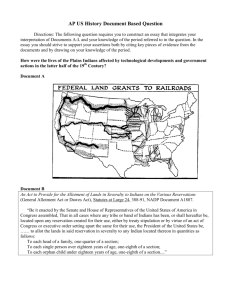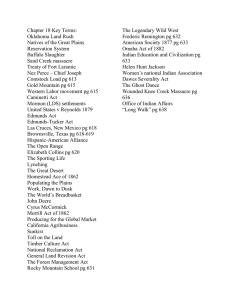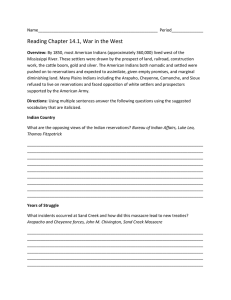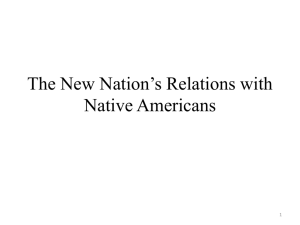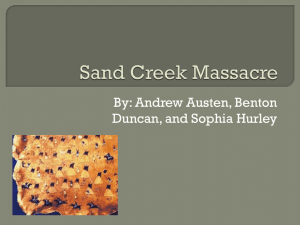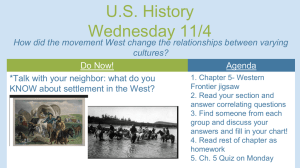native american document stations
advertisement
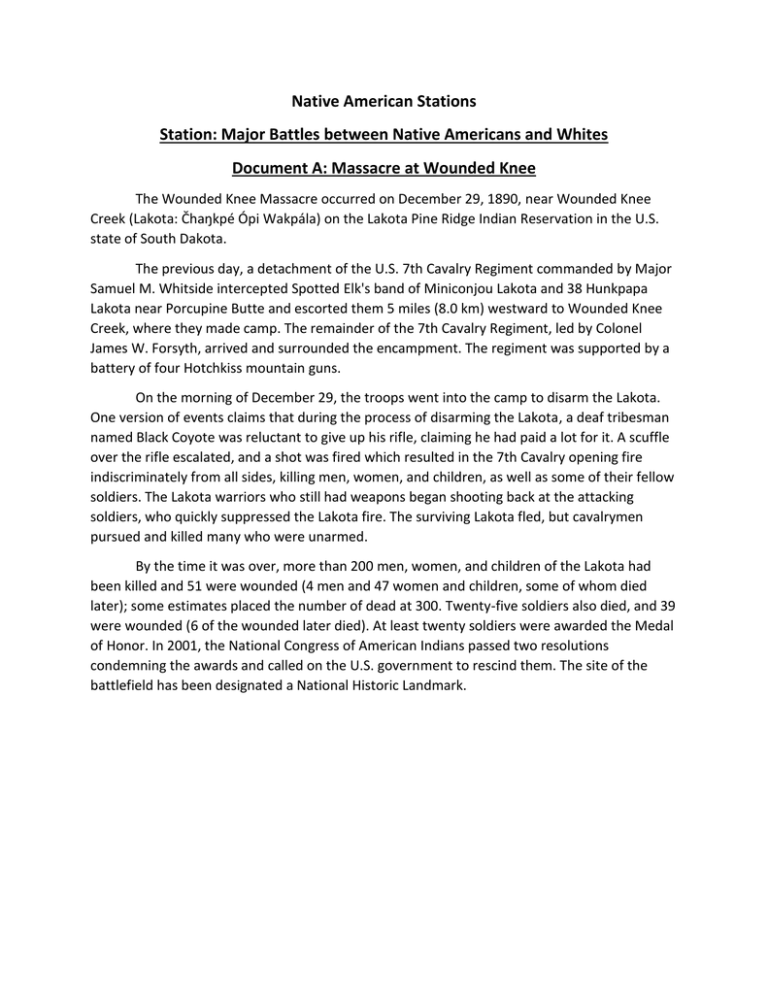
Native American Stations Station: Major Battles between Native Americans and Whites Document A: Massacre at Wounded Knee The Wounded Knee Massacre occurred on December 29, 1890, near Wounded Knee Creek (Lakota: Čhaŋkpé Ópi Wakpála) on the Lakota Pine Ridge Indian Reservation in the U.S. state of South Dakota. The previous day, a detachment of the U.S. 7th Cavalry Regiment commanded by Major Samuel M. Whitside intercepted Spotted Elk's band of Miniconjou Lakota and 38 Hunkpapa Lakota near Porcupine Butte and escorted them 5 miles (8.0 km) westward to Wounded Knee Creek, where they made camp. The remainder of the 7th Cavalry Regiment, led by Colonel James W. Forsyth, arrived and surrounded the encampment. The regiment was supported by a battery of four Hotchkiss mountain guns. On the morning of December 29, the troops went into the camp to disarm the Lakota. One version of events claims that during the process of disarming the Lakota, a deaf tribesman named Black Coyote was reluctant to give up his rifle, claiming he had paid a lot for it. A scuffle over the rifle escalated, and a shot was fired which resulted in the 7th Cavalry opening fire indiscriminately from all sides, killing men, women, and children, as well as some of their fellow soldiers. The Lakota warriors who still had weapons began shooting back at the attacking soldiers, who quickly suppressed the Lakota fire. The surviving Lakota fled, but cavalrymen pursued and killed many who were unarmed. By the time it was over, more than 200 men, women, and children of the Lakota had been killed and 51 were wounded (4 men and 47 women and children, some of whom died later); some estimates placed the number of dead at 300. Twenty-five soldiers also died, and 39 were wounded (6 of the wounded later died). At least twenty soldiers were awarded the Medal of Honor. In 2001, the National Congress of American Indians passed two resolutions condemning the awards and called on the U.S. government to rescind them. The site of the battlefield has been designated a National Historic Landmark. Document B: Sand Creek Massacre The Sand Creek massacre (also known as the Chivington massacre, the Battle of Sand Creek or the massacre of Cheyenne Indians) was an atrocity in the American Indian Wars that occurred on November 29, 1864, when a 700-man force of Colorado Territory militia attacked and destroyed a peaceful village of Cheyenne and Arapaho in southeastern Colorado Territory, killing and mutilating an estimated 70–163 Native Americans, about two-thirds of whom were women and children. The location has been designated the Sand Creek Massacre National Historic Site and is administered by the National Park Service. Black Kettle, leading chief of around 800 mostly Southern Cheyenne, had led his band, joined by some Arapahos under Chief Niwot, to Fort Lyon in compliance with provisions of a peace parley held in Denver in September 1864.[18] After a while, the Native Americans were requested to relocate to Big Sandy Creek, less than 40 miles northwest of Fort Lyon, with the guarantee of "perfect safety" remaining in effect. The Dog Soldiers, who had been responsible for many of the attacks and raids on whites, were not part of this encampment. On the 29th of November, assured by promises of protection by the commander of Fort Lyon, most of the warriors left to hunt buffalo, leaving only about 75 men, plus all the women and children in the village. The men who remained stayed were mostly too old or too young to hunt. Black Kettle flew an American flag, with a white flag tied beneath it, over his lodge, as the Fort Lyon commander had advised him. This was to show he was friendly and forestall any attack by the Colorado soldiers. Meanwhile, Chivington and 700 men of the 1st Colorado Cavalry, 3rd Colorado Cavalry, and a company of the 1st Regiment New Mexico Volunteer Cavalry, rode to Fort Lyon. They then set out for Black Kettle's encampment. James Beckwourth, noted frontiersman, acted as guide for Chivington. On the evening of November 28, the soldiers and militia drank whiskey and celebrated their anticipated easy victory. The following morning, Chivington gave the order to attack. Two officers, Captain Silas Soule and Lieutenant Joseph Cramer, commanding Company D and Company K of the First Colorado Cavalry, refused to obey and told their men to hold fire. However, the rest of Chivington's men immediately attacked the village. Ignoring the American flag and a white flag that was run up shortly after the attack began, they murdered as many of the Indians as they could. Document C: Primary Accounts of the Sand Creek Massacre I saw the bodies of those lying there cut all to pieces, worse mutilated than any I ever saw before; the women cut all to pieces ... With knives; scalped; their brains knocked out; children two or three months old; all ages lying there, from sucking infants up to warriors ... By whom were they mutilated? By the United States troops ... — - John S. Smith, Congressional Testimony of Mr. John S. Smith, 1865 I saw one squaw lying on the bank, whose leg had been broken. A soldier came up to her with a drawn sabre. She raised her arm to protect herself; he struck, breaking her arm. She rolled over, and raised her other arm; he struck, breaking that, and then left her without killing her. I saw one squaw cut open, with an unborn child lying by her side. — Robert Bent, New York Tribune, 1879 There was one little child, probably three years old, just big enough to walk through the sand. The Indians had gone ahead, and this little child was behind, following after them. The little fellow was perfectly naked, travelling in the sand. I saw one man get off his horse at a distance of about seventy-five yards and draw up his rifle and fire. He missed the child. Another man came up and said, 'let me try the son of a b-. I can hit him.' He got down off his horse, kneeled down, and fired at the little child, but he missed him. A third man came up, and made a similar remark, and fired, and the little fellow dropped. — Major Anthony, New York Tribune, 1879 Fingers and ears were cut off the bodies for the jewelry they carried. The body of White Antelope, lying solitarily in the creek bed, was a prime target. Besides scalping him the soldiers cut off his nose, ears, and testicles-the last for a tobacco pouch ... — - Stan Hoig Jis to think of that dog Chivington and his dirty hounds, up thar at Sand Creek. His men shot down squaws, and blew the brains out of little innocent children. You call sich soldiers Christians, do ye? And Indians savages? What der yer 'spose our Heavenly Father, who made both them and us, thinks of these things? I tell you what, I don't like a hostile red skin any more than you do. And when they are hostile, I've fought 'em, hard as any man. But I never yet drew a bead on a squaw or papoose, and I despise the man who would. — - Kit Carson Document D: The Great Sioux War of 1876 The Great Sioux War of 1876, also known as the Black Hills War, was a series of battles and negotiations which occurred between 1876 and 1877 involving the Lakota Sioux and Northern Cheyenne against the United States. The cause of the war was the desire of the U.S. government to obtain ownership of the Black Hills. Gold had been discovered in the Black Hills, settlers began to encroach onto Native American lands, and the Sioux and Cheyenne refused to cede ownership to the U.S. Traditionally, the United States military and historians place the Lakota at the center of the story, especially given their numbers, but some Native Americans believe the Cheyenne were the primary target of the U.S. campaign and that it should have been called "The Great Cheyenne War". Among the many battles and skirmishes of the war was the Battle of the Little Bighorn, often known as Custer's Last Stand, the most storied of the many encounters between the U.S. army and mounted Plains Indians. That Indian victory notwithstanding, the U.S. with its superior resources was soon able to force the Indians to surrender, primarily by attacking and destroying their encampments and property. The Great Sioux War took place under the presidencies of Ulysses S. Grant and Rutherford B. Hayes. The Agreement of 1877 (19 Stat. 254, enacted February 28, 1877) officially annexed Sioux land and permanently established Indian reservations. Document E: Battle of Little Bighorn The Battle of the Little Bighorn, known to Lakota as the Battle of the Greasy Grass, and commonly referred to as Custer's Last Stand, was an armed engagement between combined forces of the Lakota, Northern Cheyenne, and Arapaho tribes, against the 7th Cavalry Regiment of the United States Army. The battle, which occurred June 25–26, 1876, near the Little Bighorn River in eastern Montana Territory, was the most prominent action of the Great Sioux War of 1876. The fight was an overwhelming victory for the Lakota, Northern Cheyenne, and Arapaho, led by several major war leaders, including Crazy Horse and Chief Gall, inspired by the visions of Sitting Bull (Tȟatȟáŋka Íyotake). The U.S. 7th Cavalry, including the Custer Battalion, a force of 700 men led by George Armstrong Custer, suffered a severe defeat. Five of the 7th Cavalry's twelve companies were annihilated; Custer was killed, as were two of his brothers, a nephew, and a brother-in-law. The total U.S. casualty count included 268 dead and 55 severely wounded (6 died from their injuries later), including 4 Crow Indian scouts and 2 Pawnee Indian scouts. Public response to the Great Sioux War varied at the time. The battle, and Custer's actions in particular, have been studied extensively by historians. Document F: Texas-Indian Wars The Texas–Indian wars were a series of 19th-century conflicts between settlers in Texas and the Southern Plains Indians. These conflicts began when the first wave of EuropeanAmerican settlers moved into Spanish Texas. They continued through Texas's time as part of Mexico, when more Europeans and Anglo-Americans arrived, to the subsequent declaration of independence by the Republic of Texas. The conflicts did not end until thirty years after Texas joined the United States. Although several Indian tribes occupied territory in the area, the preeminent nation was the Comanche, known as the "Lords of the Plains." Their territory, the Comancheria, was the most powerful entity and persistently hostile to the Spanish, the Mexicans, and finally, the Texans. The half-century struggle between the Plains tribes and the Texans became particularly intense after the Spanish, and then Mexicans, left power in Texas. The Republic of Texas, which had increasing settlement by European Americans, and the United States opposed the tribes. Their war with the Plains Indians was characterized by deep animosity, slaughter on both sides, and, in the end, near-total conquest of the Indians. Although the outcome was lop-sided, the violence of the wars was not. The Comanche were known as fierce warriors, with a reputation for looting, burning, murdering, and kidnapping as far south as Mexico City. They killed and captured so many Texans that Comanche became a by-word for terrorism in this region. When Sul Ross recovered Cynthia Ann Parker at Pease River, he observed that this event would be felt in every family in Texas, as everyone had lost someone in the Indian Wars. During the American Civil War, when the US Army was unavailable to protect the frontier, the Comanche and Kiowa pushed white settlements back more than 100 miles along the Texas frontier. Station: American Perspective Document A: “If you strike off into the broad, free West, and make yourself a farm from Uncle Sam’s generous domain, you will crowd nobody, starve nobody, and neither you nor your children need evermore beg…” -New York Tribune, February 5, 1867 Document B: “Doubtless it will be painful to leave the graves of their fathers; but what do they more than our ancestors did or than our children are now doing?.... Can it be cruel in this Government when, by events which it cannot control, the Indian is made discontented in his ancient home to purchase his lands, to give him a new and extensive territory, to pay the expense of his removal, and support him a year in his new abode? How many thousands of our own people would gladly embrace the opportunity of removing to the West on such conditions! If the offers made to the Indians were extended to them, they would be hailed with gratitude and joy…. Rightly considered, the policy of the General Government toward the red man is not only liberal, but generous. He is unwilling to submit to the laws of the States and mingle with their population. To save him from this alternative, or perhaps utter annihilation, the General Government kindly offers him a new home, and proposes to pay the whole expense of his removal and settlement.” -Andrew Jackson, State of the Union speech. December 30, 1830. Document C: “This is our country, not the Apaches’. American blood and treasure secured it form Mexico…The American people cannot now do otherwise than help us to fight the great battle of civilization; to overthrow the barbarians and teach them that white supremacy, even in Arizona, is decreed of God.” -Editorial in the Weekly Arizona Miner, July 1871 “So long as an Indian has life and power he is dangerous, and this is particularly true of the fiendish Apache. There can be no hope of peace or prosperity in Arizona until he is exterminated or forced to accept a reservation.” -Editorial in the Weekly Arizona Miner, 1864 “The mistaken philathropists of the East have not the most remote conception of the Apache character… The effect of their policy is terrible on this far West border; and these men who are pleading for soft measures with the Apaches are guilty of the blood of the murdered pioneers of Arizona and New Mexico.” -Editorial in the Weekly Arizonian, 1870 Document D: Helen Hunt Jackson grew up in Massachusetts. In the late 1870s, she heard some Native Americans speak about their people’s plight. Deeply moved, she was determined to publicize their cause. In a Century of Dishonor, she sharply criticized the U.S. government’s history of shattered treaties. She elaborated on the situation in a report on Indian policy written for the government and in the highly popular novel Ramona. Jackson’s work helped build sympathy for the plight of Native Americans. “There is not among these three hundred bands of Indians one which has not suffered cruelly at the hands either of the Government or of white settlers. The poorer, the more insignificant, the more helpless the band, the more certain the cruelty and outrage to which they have been subjected… It makes little difference where one opens the record of the history of the Indians; every page and every year has its dark stain.” -Helen Hunt Jackson, 1881 Document E: “It would be foolish to expect that the wild Indians will become industrious and frugal except through a severe course of industrial instruction and exercise under restraint. The reservation system affords the place for the stealing with tribes and bands, it is essential that the right of the government to keep Indians upon the reservations assigned to them and to rest and return them whenever they wonder should be placed beyond dispute. Without this whenever these people become restive under compulsion to labor they will break away in their old rubbing spirit and stay off in small bands to neighboring communities upon which they will pray in a petty fashion by begging and stealing.” -Annual Report of the Commissioner of Indian Affairs, 1872 Document F: “It has become a matter of serious import whether the treaty system and use ought longer to be continued. In my judgment it should not. A treaty involves the idea of a compact between two or more sovereign powers, each possessing sufficient authority and forced to compel a compliance with the obligations incurred. The Indian tribes of the United States are not sovereign nations, capable of making treaties, as none of them have an organized government of such inherent strength as would secure a faithful obedience of its people in the observance of compacts of this character. They are held to be the wards of the government but, because treaties have been made with them, they have become falsely impressed with the notion of national independence… Great injury has been done by the government in deluding this people into the belief of their being independent sovereignties, while they were at the same time recognized only as its dependents and wards.” -Commissioner of India Affairs Ely S. Parker, December 23, 1869. Station: Native American Perspective Document A: “All men were made by the same Great Spirit Chief. They are all brothers. The earth is the mother of all people and all people should have equal rights upon it. You might as well expect all rivers to run back where does that any man who was born a free man should be contented penned up and did not liberty to go where he pleases. If you tie a horse to a stake, do you expect he will grow fat? If you pin and Indian up on a small spot of Earth and compel him to stay there, he will not be contented nor will he grow and prosper. I have asked some of the great white Chiefs where they get their authority to say to be Indian that he shall stay in one place, while he sees Whiteman going where they please. They cannot tell me.” -Chief Joseph, Nez Perce Document B: “In order to become sole masters of our land they relegated us to small reservations as big as my hand and make us long promises, as long as my arm; but the next year the promises were shorter and got shorter every year until now they are the length of my finger, and they keep only half of that.” -Chief Piapot, 1895 Native American Perspectives American Settlers and Government Perspective Major Conflicts Between Native Americans and the United States

